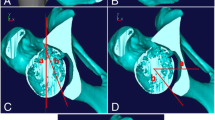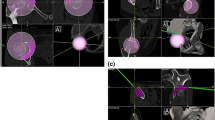Abstract
Purpose
To present a novel surgical technique for the Bernese peri-acetabular osteotomy (PAO) using electromagnetic navigation (EMN) and patient-specific templates (PST), and to evaluate it against the traditional fluoroscopic technique.
Methods
We included 40 dysplastic hips. All PAOs were performed using PST and EMN. We recorded learning-related complications. For the purpose of acetabular fragment correction analysis, patients were divided into two groups. In the study group (EMN group, 30 hips), the acetabular fragment was reoriented with the help of EMN. In the control group (XR group, 10 hips), the acetabular fragment was reoriented using fluoroscopy. We compared the difference between the planned and achieved position of the acetabular fragment and outcomes between both groups.
Results
Two major complications occurred in four PAOs in the XR group only (first ten PAOs). The average absolute difference in planned and achieved lateral centre -edge angle (LCEA) and acetabular index (AI) was 1.2° ± 1.5° and 1.1° ± 2° for the EMN and 7° ± 6.1° and 6.3° ± 6.3° for the XR group (p = 0.02; p = 0.03). The average surgery duration was 183 ± 32 minutes for the EMN and 203 ± 42 minutes for the XR group (p = 0.19). At the last follow-up, the average Harris Hip Score (HHS) value was 88 ± 12 in the EMN and 86 ± 14 in the XR group (p = 0.84).
Conclusions
Our study indicates that PAO performed with EMN and PST seems to be a safe and reproducible procedure with a short learning curve. Additionally, navigated reorientation of the acetabular fragment is significantly more accurate than the fluoroscopic technique.





Similar content being viewed by others

Data availability
Raw data (clinical, radiography) were generated at the Valdoltra Orthopaedic Hospital, Ankaran, Slovenia. Derived anonymized data supporting findings of this study are available from the corresponding author upon request.
References
Kamath AF (2016) Bernese periacetabular osteotomy for hip dysplasia: surgical technique and indications. World J Orthop 7:280. https://doi.org/10.5312/wjo.v7.i5.280
Ganz R, Klaue K, Vinh TS, Mast JW (1988) A new periacetabular osteotomy for the treatment of hip dysplasias technique and preliminary results. Clin Orthop 232:26–36
Siebenrock KA, Schöll E, Lottenbach M, Ganz R (1999) Bernese periacetabular osteotomy. Clin Orthop 363:9–20
Siebenrock KA, Schaller C, Tannast M et al (2014) Anteverting periacetabular osteotomy for symptomatic acetabular retroversion: results at ten years. J Bone Joint Surg Am 96:1785–1792. https://doi.org/10.2106/JBJS.M.00842
Steppacher SD, Tannast M, Ganz R, Siebenrock KA (2008) Mean 20-year followup of Bernese periacetabular osteotomy. Clin Orthop 466:1633–1644. https://doi.org/10.1007/s11999-008-0242-3
Lerch TD, Steppacher SD, Liechti EF et al (2017) One-third of hips after periacetabular osteotomy survive 30 years with good clinical results, no progression of arthritis, or conversion to THA. Clin Orthop 475:1154–1168. https://doi.org/10.1007/s11999-016-5169-5
Clohisy JC, Schutz AL, St. John L et al (2009) Periacetabular osteotomy: a systematic literature review. Clin Orthop 467:2041–2052. https://doi.org/10.1007/s11999-009-0842-6
Wirth SH, Rahm S, Kamath AF et al (2020) Periacetabular osteotomy using three-dimensional cutting and reposition guides: a cadaveric study. J Hip Preserv Surg. https://doi.org/10.1093/jhps/hnz051
Peters CL (2006) Early results of the Bernese periacetabular osteotomy: the learning curve at an academic medical center. J Bone Jt Surg Am 88:1920. https://doi.org/10.2106/JBJS.E.00515
Davey JP, Santore RF (1999) Complications of periacetabular osteotomy. Clin Orthop:33–37
Hussell JG, Rodriguez JA, Ganz R (1999) Technical Complications of the Bernese periacetabular osteotomy. Clin Orthop Relat Res 363:81–92
Büchler L, Beck M (2014) Periacetabular osteotomy: a review of swiss experience. Curr Rev Musculoskelet Med 7:330–336. https://doi.org/10.1007/s12178-014-9232-0
Trousdale RT, Cabanela ME (2003) Lessons learned after more than 250 periacetabular osteotomies. Acta Orthop Scand 74:119–126. https://doi.org/10.1080/00016470310013824
Kralj M, Mavčič B, Antolič V et al (2005) The Bernese periacetabular osteotomy: clinical, radiographic and mechanical 7–15-year follow-up of 26 hips. Acta Orthop 76:833–840. https://doi.org/10.1080/17453670510045453
Mihalič R, Trebše R (2014) Modern approach to periacetabular osteotomy performed with osteotomy guiding jigs and navigation. 11th EHS Congress Stockholm, Sweden
Mihalič R, Trebše R, Kreuh D (2013) Computer aided periacetabular osteotomy performed with CAD-CAM osteotomy guiding jig. Orthop Proc 95-B:Supp_34
Siebenrock KA, Steppacher SD, Tannast M, Büchler L (2015) Anteverting periacetabular osteotomy for acetabular retroversion. JBJS Essent Surg Tech 5:e1. https://doi.org/10.2106/JBJS.ST.N.00036
Zou Z, Chávez-Arreola A, Mandal P et al (2013) Optimization of the position of the acetabulum in a ganz periacetabular osteotomy by finite element analysis. J Orthop Res 31:472–479. https://doi.org/10.1002/jor.22245
Clavien PA, Sanabria JR, Strasberg SM (1992) Proposed classification of complications of surgery with examples of utility in cholecystectomy. Surgery 111:518–526
Dindo D, Demartines N, Clavien P-A (2004) Classification of surgical complications: a new proposal with evaluation in a cohort of 6336 patients and results of a survey. Ann Surg 240:205–213. https://doi.org/10.1097/01.sla.0000133083.54934.ae
Akiyama H, Goto K, So K, Nakamura T (2010) Computed tomography-based navigation for curved periacetabular osteotomy. J Orthop Sci 15:829–833. https://doi.org/10.1007/s00776-010-1520-y
Langlotz F, Bächler R, Berlemann U et al (1998) Computer assistance for pelvic osteotomies. Clin Orthop 354:92–102. https://doi.org/10.1097/00003086-199809000-00012
Langlotz F, Stucki M, Bächler R et al (1997) The first twelve cases of computer assisted periacetabular osteotomy. Comput Aided Surg Off J Int Soc Comput Aided Surg 2:317–326. https://doi.org/10.1002/(SICI)1097-0150(1997)2:6<317::AID-IGS1>3.0.CO;2-2
Mayman DJ, Rudan J, Yach J, Ellis R (2002) The Kingston periacetabular osteotomy utilizing computer enhancement: a new technique. Comput Aided Surg 7:179–186. https://doi.org/10.3109/10929080209146028
Wong KC, Kumta SM, Leung KS et al (2010) Integration of CAD/CAM planning into computer assisted orthopaedic surgery. Comput Aided Surg 15:65–74. https://doi.org/10.3109/10929088.2010.514131
Kamath AF, Mays RR (2019) Periacetabular osteotomy performed with imageless computer-assisted navigation: case report. Case Rep Orthop Res 2:33–39. https://doi.org/10.1159/000501545
Hooper JM, Mays RR, Poultsides LA et al (2019) Periacetabular osteotomy using an imageless computer-assisted navigation system: a new surgical technique. J Hip Preserv Surg 6:426–431. https://doi.org/10.1093/jhps/hnz058
Imai H, Kamada T, Miyawaki J et al (2020) Outcomes of computer-assisted peri-acetabular osteotomy compared with conventional osteotomy in hip dysplasia. Int Orthop 44:1055–1061. https://doi.org/10.1007/s00264-020-04578-x
Clohisy JC, Nunley RM, Curry MC, Schoenecker PL (2007) Periacetabular osteotomy for the treatment of acetabular dysplasia associated with major aspherical femoral head deformities. J Bone Joint Surg Am 89:1417–1423. https://doi.org/10.2106/JBJS.F.00493
Trousdale RT, Ekkernkamp A, Ganz R, Wallrichs SL (1995) Periacetabular and intertrochanteric osteotomy for the treatment of osteoarthrosis in dysplastic hips. J Bone Joint Surg Am 77:73–85. https://doi.org/10.2106/00004623-199501000-00010
Wang X, Liu S, Peng J et al (2019) Development of a novel customized cutting and rotating template for Bernese periacetabular osteotomy. J Orthop Surg 14:217. https://doi.org/10.1186/s13018-019-1267-x
Li J, Gao X, Li X (2019) Comparison of iASSIST navigation system with conventional techniques in total knee arthroplasty: a systematic review and meta-analysis of radiographic and clinical outcomes. Orthop Surg 11:985–993. https://doi.org/10.1111/os.12550
Cheng H, Chen BP-H, Soleas IM et al (2017) Prolonged operative duration increases risk of surgical site infections: a systematic review. Surg Infect 18:722–735. https://doi.org/10.1089/sur.2017.089
Trumble SJ, Mayo KA, Mast JW (1999) The periacetabular osteotomy. Minimum 2 year followup in more than 100 hips. Clin Orthop:54–63
Mayo KA, Trumble SJ, Mast JW (1999) Results of periacetabular osteotomy in patients with previous surgery for hip dysplasia. Clin Orthop:73–80
Author information
Authors and Affiliations
Corresponding author
Ethics declarations
Conflict of interest
The authors declare that they have no conflict of interest.
Ethics approval
The study was approved by the Ethics Committee of the Valdoltra Orthopaedic Hospital (No. 3/2019).
Informed consent
Informed consent was obtained from patients for their anonymized data to be published in this article.
Additional information
Publisher’s note
Springer Nature remains neutral with regard to jurisdictional claims in published maps and institutional affiliations.
Supplementary Information
(MOV 74465 kb)
(MOV 12744 kb)
Rights and permissions
About this article
Cite this article
Mihalič, R., Brumat, P. & Trebše, R. Bernese peri-acetabular osteotomy performed with navigation and patient-specific templates is a reproducible and safe procedure. International Orthopaedics (SICOT) 45, 883–889 (2021). https://doi.org/10.1007/s00264-020-04897-z
Received:
Accepted:
Published:
Issue Date:
DOI: https://doi.org/10.1007/s00264-020-04897-z



